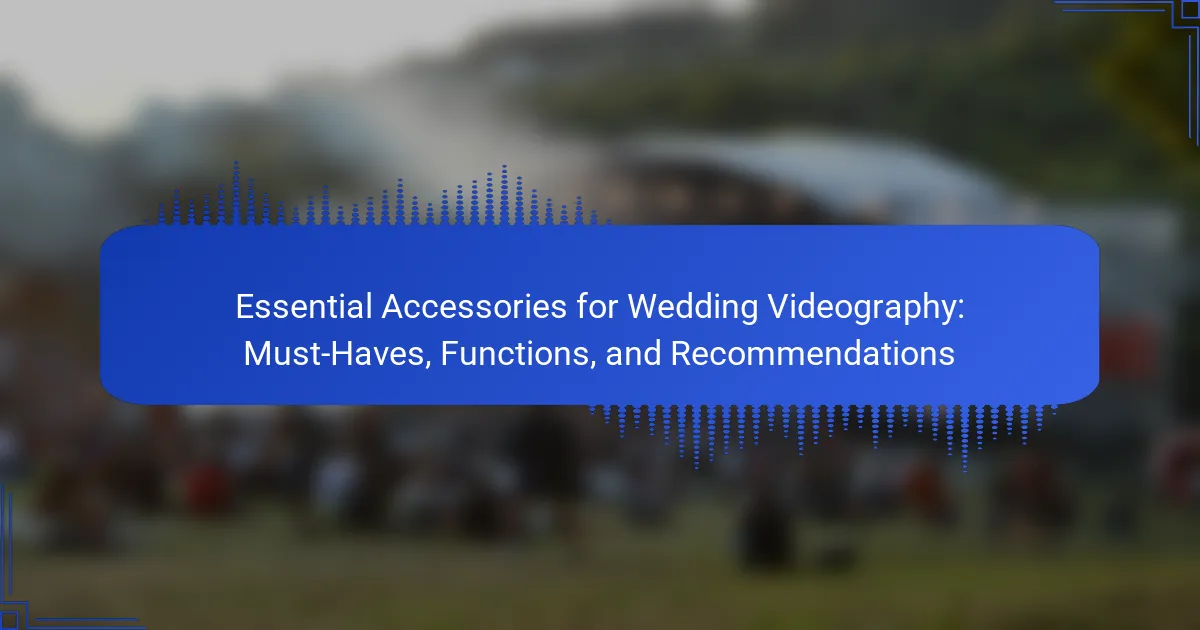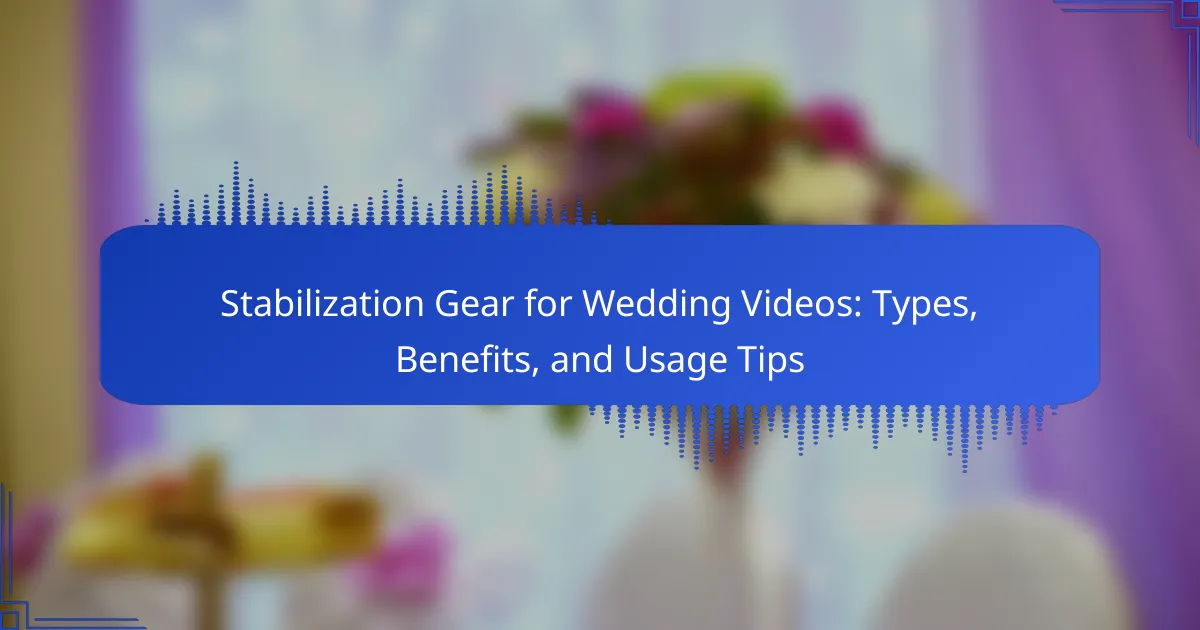Microphones for wedding videography are essential audio devices that capture sound during wedding events, ensuring high-quality recordings of vows, speeches, and ambient sounds. Key types include lavalier microphones, which are discreet and ideal for individual voices; shotgun microphones, which are directional and suitable for capturing speeches from a distance; and handheld microphones, which allow for dynamic use during toasts and interviews. The article provides guidance on selecting the appropriate microphone based on the environment and audio needs, emphasizing the importance of quality, placement, and monitoring to enhance overall sound clarity in wedding videos. Additionally, it highlights best practices for microphone placement to achieve optimal audio capture throughout the event.
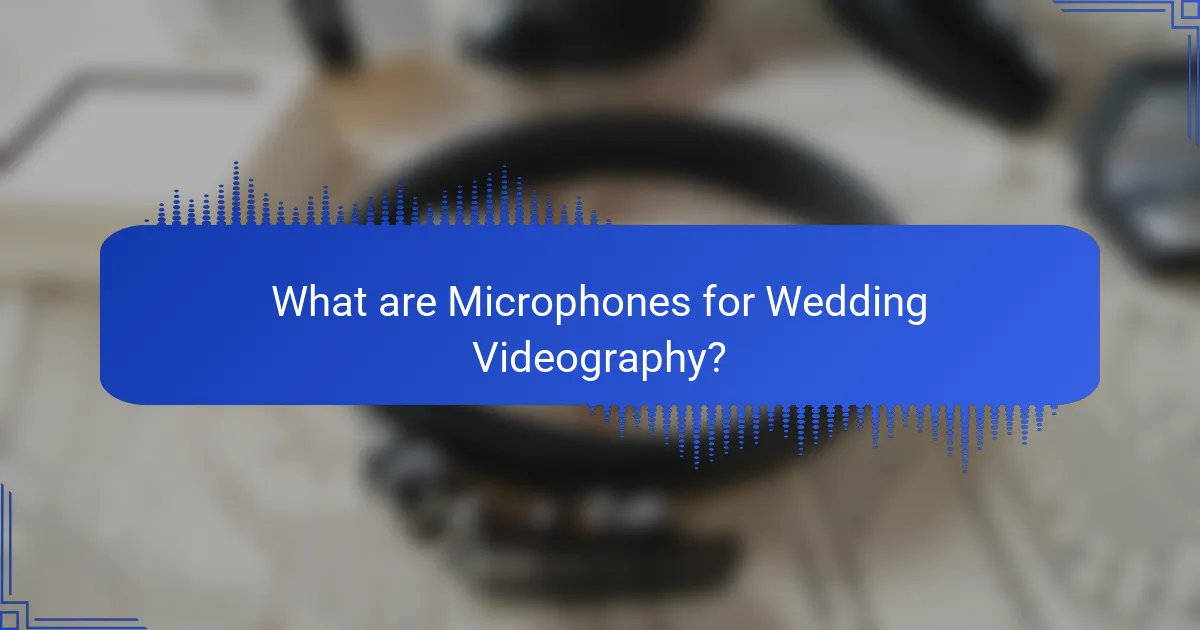
What are Microphones for Wedding Videography?
Microphones for wedding videography are specialized audio devices used to capture sound during wedding events. They ensure high-quality audio recording of vows, speeches, and ambient sounds. Common types include lavalier microphones, shotgun microphones, and handheld microphones. Lavalier microphones are discreet and clip onto clothing, making them ideal for capturing individual voices. Shotgun microphones are directional and can pick up sound from a distance, suitable for capturing speeches without background noise. Handheld microphones allow for dynamic use during toasts and interviews. Quality microphones enhance the overall video production by providing clear and professional audio.
How do Microphones enhance Wedding Videography?
Microphones enhance wedding videography by capturing clear and high-quality audio. High-quality audio complements the visual storytelling of the wedding. Clear dialogue from vows and speeches is essential for preserving the emotional impact. Ambient sound, such as laughter and music, adds depth to the final video. Wireless microphones allow for freedom of movement, ensuring unobtrusive recording. Directional microphones can isolate sound sources, reducing background noise. The right microphone placement is crucial for optimal sound capture. Overall, microphones significantly elevate the production value of wedding videos.
What types of audio do Microphones capture during weddings?
Microphones capture various types of audio during weddings. They record spoken words, such as vows and speeches. Ambient sounds, like music and laughter, are also captured. Additionally, microphones can pick up background noise, including nature sounds or venue acoustics. Each type of audio contributes to the overall wedding experience. High-quality microphones enhance clarity and detail in recordings. This is crucial for preserving memories. Proper microphone placement further optimizes audio capture during the event.
How do Microphones impact the overall video quality?
Microphones significantly impact overall video quality by capturing audio clarity and richness. High-quality microphones reduce background noise and enhance vocal clarity. This leads to a more immersive viewing experience. Poor audio quality can distract viewers and diminish the perceived professionalism of the video. Studies show that viewers often associate good audio with high production value. For instance, a report by the National Academy of Television Arts and Sciences indicates that audio quality is a critical factor in audience engagement. Thus, selecting the right microphone type and placement is essential for optimal video quality.
Why is Microphone Quality Important for Wedding Videography?
Microphone quality is crucial for wedding videography because it directly affects audio clarity and overall production value. High-quality microphones capture clear and detailed sound, ensuring that vows, speeches, and ambient sounds are recorded accurately. Poor microphone quality can lead to distorted audio or background noise, distracting from the emotional moments of the ceremony. Research indicates that 70% of viewers find audio quality more important than video quality in wedding films. Clear audio enhances storytelling and helps convey the couple’s emotions effectively. Therefore, investing in quality microphones is essential for producing memorable and engaging wedding videos.
What factors determine the quality of a Microphone?
The quality of a microphone is determined by several key factors. These include frequency response, sensitivity, and signal-to-noise ratio. Frequency response defines the range of sound frequencies a microphone can capture. A wider frequency response typically results in better audio quality. Sensitivity measures how effectively a microphone converts sound into an electrical signal. Higher sensitivity often leads to clearer recordings. Signal-to-noise ratio indicates the level of background noise in relation to the audio signal. A higher ratio means less interference from unwanted sounds. Additionally, build quality and diaphragm type also influence microphone performance. Dynamic microphones are durable and handle high sound pressure levels well. Condenser microphones offer greater sensitivity and are ideal for capturing detailed sound. Each of these factors plays a crucial role in determining overall microphone quality.
How does Microphone quality affect the viewer’s experience?
Microphone quality directly impacts the viewer’s experience by influencing audio clarity and engagement. High-quality microphones capture clear sound, making dialogue and ambient noise more distinct. This clarity helps viewers understand conversations better, enhancing storytelling. Poor-quality microphones can introduce distortion or background noise, distracting viewers and detracting from emotional impact. Research indicates that 70% of viewers prioritize audio quality over video quality when watching content. Thus, investing in high-quality microphones is essential for creating a compelling viewing experience.
What are the Different Types of Microphones for Wedding Videography?
The different types of microphones for wedding videography include lavalier, shotgun, handheld, and boundary microphones. Lavalier microphones are small and clip onto clothing, providing hands-free operation. They are ideal for capturing dialogue discreetly during ceremonies and speeches. Shotgun microphones are highly directional, capturing sound from a specific area while minimizing background noise. They are often mounted on cameras or boom poles. Handheld microphones are commonly used by hosts or interviewers for direct engagement. They allow for easy mobility and control over audio capture. Boundary microphones are placed on surfaces to capture ambient sound and are useful for recording music or group discussions. Each microphone type serves a unique purpose in wedding videography, enhancing audio quality and clarity.
What are the advantages of using Lavalier Microphones?
Lavalier microphones provide several advantages for capturing audio in wedding videography. They are small and discreet, allowing for unobtrusive placement on speakers. This feature is particularly beneficial during ceremonies and speeches, as it minimizes distractions. Lavalier microphones also offer hands-free operation, enabling speakers to move naturally without holding a microphone. Their ability to capture clear audio from a close distance enhances sound quality significantly. Many models are wireless, allowing for greater freedom of movement. Additionally, they can be easily clipped to clothing, ensuring consistent audio levels. These attributes contribute to a professional audio experience in wedding videography.
How do Shotgun Microphones differ from other types?
Shotgun microphones differ from other types by their highly directional pickup pattern. They are designed to capture sound from a specific source while minimizing background noise. This makes them ideal for situations where clarity and focus on a subject are crucial, such as wedding videography. Unlike omnidirectional microphones, which pick up sound from all directions, shotgun microphones primarily capture sound from the front. They typically feature a long, narrow shape that enhances their directivity. This design helps isolate the desired audio, making it easier to record clear dialogue or specific sounds. Shotgun microphones are often used in film and video production for this reason. Their effectiveness in noisy environments is a key advantage over other microphone types.
When should you use Handheld Microphones in weddings?
Handheld microphones should be used during weddings when clear audio capture is essential. They are ideal for speeches, toasts, and live performances. Handheld microphones allow speakers to move freely while maintaining audio quality. They are also effective in outdoor settings where wind noise may interfere. Additionally, these microphones can be used for interviews with guests. Their design enables easy handling and positioning for optimal sound capture. The versatility of handheld microphones makes them suitable for various wedding scenarios.
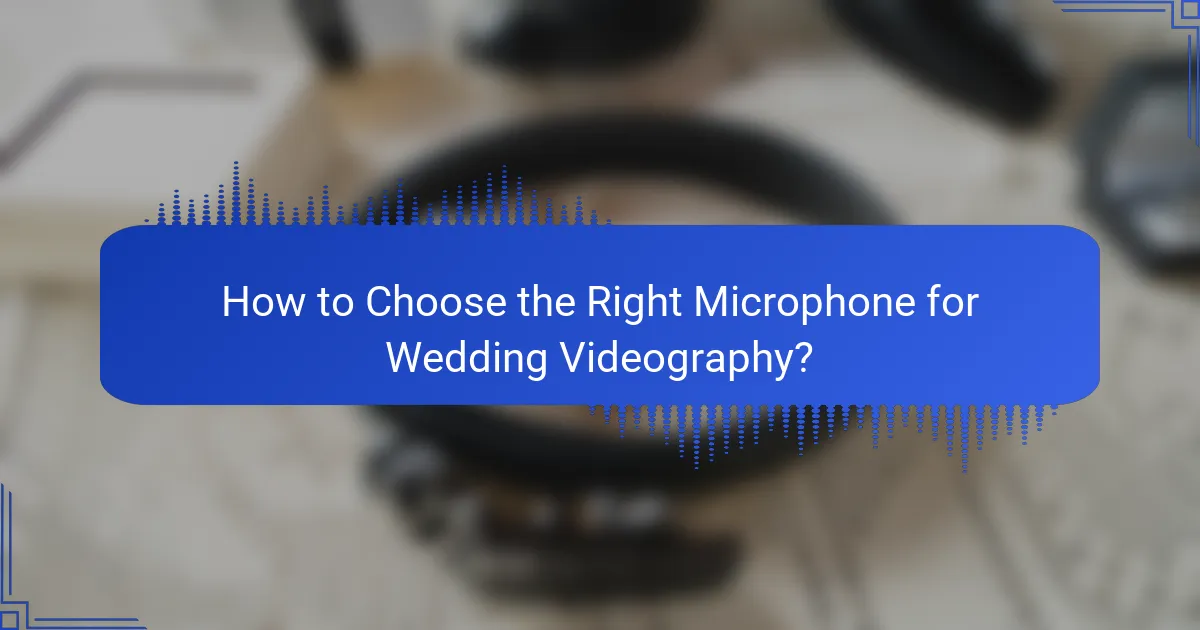
How to Choose the Right Microphone for Wedding Videography?
To choose the right microphone for wedding videography, select based on the environment and audio needs. Consider using shotgun microphones for focused sound capture. Lavalier microphones are ideal for interviews and speeches, providing discreet placement. Wireless options enhance mobility, crucial for dynamic wedding settings. Evaluate microphone sensitivity and frequency response to ensure clarity. Durability is essential, as wedding events can be unpredictable. Research shows that high-quality audio significantly impacts viewer engagement and satisfaction.
What considerations should you keep in mind when selecting a Microphone?
When selecting a microphone, consider the type of microphone that best suits your needs. Dynamic microphones are durable and handle high sound pressure levels well. Condenser microphones capture a wider frequency range and are sensitive to softer sounds. Assess the microphone’s polar pattern; cardioid patterns are ideal for isolating sound from specific directions. Check the frequency response to ensure it captures the audio spectrum you need. Evaluate the microphone’s connectivity options; XLR connections provide better audio quality than 3.5mm jacks. Consider the microphone’s size and weight, especially for mobile setups. Assess the budget, as prices can vary significantly based on quality and features. Lastly, read reviews and test the microphone when possible to ensure it meets your expectations.
How does the wedding environment influence Microphone choice?
The wedding environment significantly influences microphone choice. Factors such as venue size, acoustics, and background noise levels determine the type of microphone needed. For instance, outdoor weddings may require windshields to minimize wind noise. In contrast, indoor venues with high ceilings may need directional microphones to capture clear audio from the couple. Additionally, crowded settings may necessitate lapel microphones for individual speakers to ensure clarity. Understanding the specific environment allows videographers to select microphones that best suit the audio capture needs of the event.
What is the role of budget in Microphone selection?
Budget plays a crucial role in microphone selection for wedding videography. The budget determines the quality and type of microphone available. Higher budgets typically allow for professional-grade microphones with superior sound quality. These microphones often feature advanced technology, such as noise cancellation and better frequency response. Conversely, lower budgets may limit options to entry-level microphones with basic features. Entry-level microphones can still capture sound but may lack clarity and detail. Therefore, understanding budget constraints helps videographers choose the right equipment for their needs. Ultimately, the chosen budget directly impacts the overall audio quality of the wedding video.
How can you assess Microphone compatibility with your videography equipment?
To assess microphone compatibility with your videography equipment, first identify the input types your camera supports. Common input types include XLR, TRS, and USB. Next, check the microphone’s output specifications to ensure they match your camera’s input. For example, XLR microphones require an XLR input on the camera.
Additionally, consider the power requirements. Some microphones need phantom power, which must be available from the camera. Verify the microphone’s frequency response and sensitivity to ensure it captures sound effectively for your specific videography needs.
Finally, consult user manuals or product specifications for both the microphone and camera. This information will confirm compatibility. Many manufacturers provide compatibility charts or guides, which can be useful resources.
What specifications should you check for compatibility?
Check the microphone’s connectivity type for compatibility with your recording device. Ensure it matches the input ports available, such as XLR, TRS, or USB. Verify the microphone’s frequency response range. It should align with the audio quality needs of wedding videography. Assess the sensitivity rating of the microphone. This indicates how well it captures quiet sounds. Confirm the power requirements, especially for condenser microphones that may need phantom power. Review the microphone’s impedance to ensure it pairs well with the input device. Lastly, check for any additional features like wireless capabilities, which enhance flexibility during events.
How do different connectors affect Microphone use?
Different connectors affect microphone use by influencing compatibility, signal quality, and ease of setup. XLR connectors provide balanced audio, reducing noise over long distances. TRS connectors offer unbalanced connections, which can be more susceptible to interference. USB connectors allow direct digital connection to computers, simplifying the recording process. Each connector type impacts the overall performance and reliability of audio capture. For instance, XLR is standard in professional settings due to its durability and superior sound quality. In contrast, TRS is often used in consumer devices where portability is key. The choice of connector ultimately affects the microphone’s application in various environments, including wedding videography.
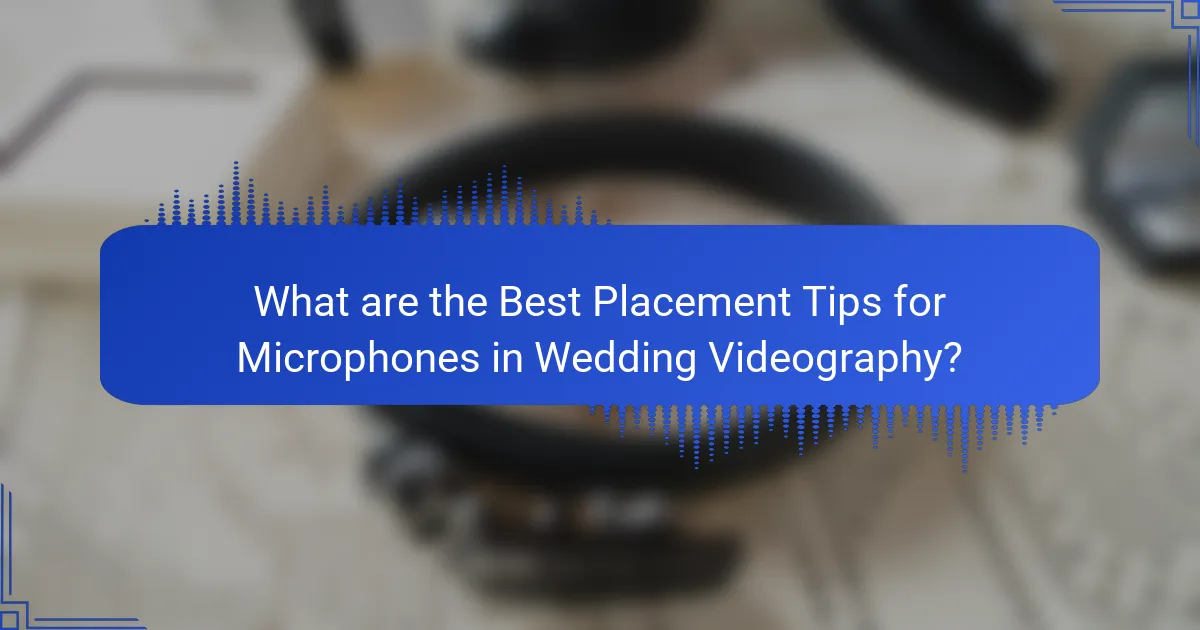
What are the Best Placement Tips for Microphones in Wedding Videography?
For optimal microphone placement in wedding videography, position the microphone close to the sound source. This ensures clear audio capture. Use lavalier microphones on the officiant and couple for hands-free operation. Place shotgun microphones on a boom pole to capture ambient sounds and vows. Avoid placing microphones near noise sources, such as speakers or guests. Test audio levels before the ceremony starts to ensure quality. Monitor audio throughout the event to catch any issues. These practices enhance the overall sound quality of wedding videos.
How should you position Microphones for optimal sound capture?
Position microphones close to the sound source for optimal sound capture. This minimizes background noise and enhances audio clarity. Directional microphones should face the sound source directly. For interviews, position the microphone 6 to 12 inches from the speaker’s mouth. Use a boom pole to keep the microphone out of the frame while capturing sound. When recording music, place microphones near the instruments for better fidelity. Avoid placing microphones near reflective surfaces that can cause echo. Testing microphone placement before recording ensures the best audio quality. Proper positioning is crucial for clear and professional sound in wedding videography.
What are the best practices for placing Lavalier Microphones?
Lavalier microphones should be placed as close to the sound source as possible. This ensures clear audio capture and minimizes background noise. Position the microphone on the speaker’s clothing, ideally between 6 to 8 inches from their mouth. Use clips or adhesive to secure the microphone discreetly. Avoid placing the microphone near fabric that may cause rustling sounds. Test the audio levels before recording to ensure optimal sound quality. Adjust the microphone position if necessary based on the speaker’s movement. Proper placement enhances the overall audio experience in wedding videography.
How can you effectively use Shotgun Microphones for group settings?
To effectively use shotgun microphones for group settings, position the microphone close to the sound source. This ensures better audio capture by minimizing background noise. Aim the microphone at the primary speaker to enhance clarity. Use a boom pole or handheld grip to maintain distance while keeping the mic directed. Test audio levels before recording to ensure optimal sound quality. Utilize windshields to reduce wind noise in outdoor settings. Consider using multiple microphones for larger groups to capture all voices. These techniques enhance sound quality and improve the overall audio experience in group settings.
What common mistakes should you avoid when placing Microphones?
Common mistakes to avoid when placing microphones include improper positioning, overlooking background noise, and neglecting to test audio levels. Positioning microphones too far from the sound source reduces audio clarity. Background noise can interfere with recordings, so choose quiet locations. Failing to test audio levels before recording can lead to distorted sound. Additionally, not securing microphones properly may result in unwanted movement or noise during filming. Lastly, using the wrong type of microphone for specific situations can diminish sound quality.
How can poor placement impact audio quality?
Poor placement of microphones can significantly degrade audio quality. When microphones are not positioned correctly, they may pick up unwanted background noise. This can overshadow the primary audio source, such as vows or speeches. Additionally, improper placement can lead to uneven sound levels. For instance, a microphone too far from the speaker will result in a weak signal. Conversely, a microphone too close may cause distortion or clipping. The acoustic environment also plays a role; reflections from walls can create echoes. Research indicates that optimal microphone placement can enhance clarity and reduce noise interference. Properly positioned microphones capture clear, balanced audio essential for wedding videography.
What are the signs of bad Microphone placement during recording?
Signs of bad microphone placement during recording include excessive background noise. Poor placement can cause the microphone to pick up unwanted sounds. These sounds may include ambient noise or other voices. Another sign is low audio quality. This can manifest as muffled or unclear sound. Distortion can also occur if the microphone is too close to a sound source. Additionally, inconsistent volume levels indicate improper placement. This may result in some parts being too loud and others too quiet. If the microphone is not directed towards the sound source, it can lead to poor audio capture. Overall, these signs indicate that the microphone is not optimally positioned for clear recording.
What are some practical tips for troubleshooting Microphone issues during weddings?
Check the microphone connection first. Ensure all cables are securely plugged in. Loose connections can cause audio dropouts. Test the microphone with a different device. This helps determine if the issue lies with the microphone or the recording equipment. Adjust the input levels on the recording device. Too high or too low levels can distort sound. Move the microphone closer to the speaker. Proximity improves audio clarity and reduces background noise. Use a windscreen if outdoors. This minimizes wind interference during recordings. Finally, conduct a sound check before the event. This allows for adjustments and ensures everything functions properly.
Microphones for wedding videography are essential audio devices that capture high-quality sound during wedding events, including vows, speeches, and ambient noise. This article covers the various types of microphones, such as lavalier, shotgun, and handheld, and emphasizes the importance of microphone quality in enhancing video production value. It also discusses factors that influence microphone choice, including the wedding environment and budget, while providing practical tips for optimal microphone placement and troubleshooting common issues. Understanding these aspects is crucial for achieving clear audio that complements the visual storytelling of wedding videos.

